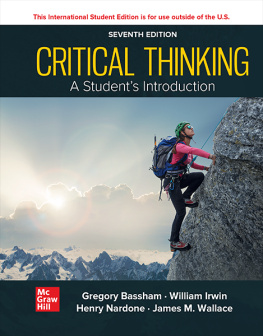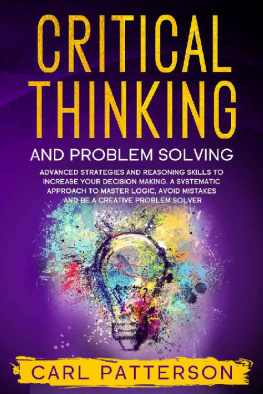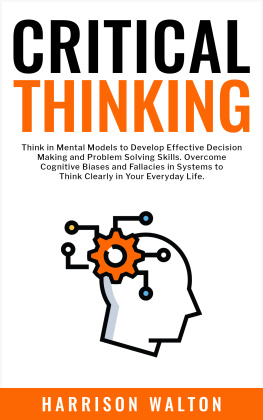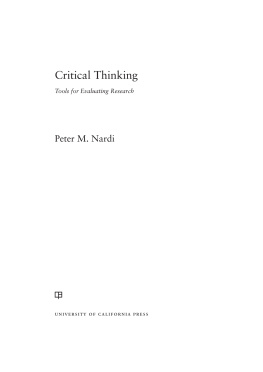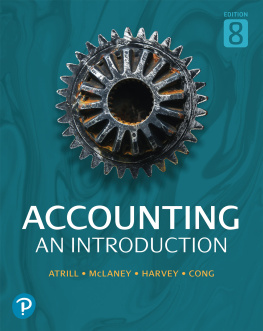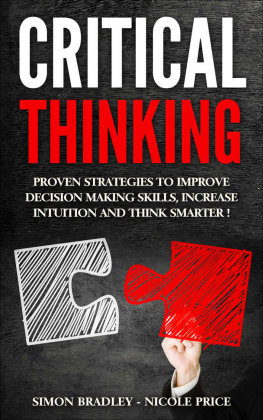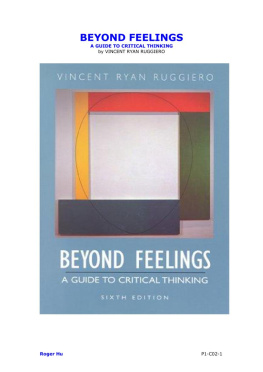
Page ii

CRITICAL THINKING
Published by McGraw Hill LLC, 1325 Avenue of the Americas, New York, NY 10019. Copyright 2023 by McGraw Hill LLC. All rights reserved. Printed in the United States of America. No part of this publication may be reproduced or distributed in any form or by any means, or stored in a database or retrieval system, without the prior written consent of McGraw Hill LLC, including, but not limited to, in any network or other electronic storage or transmission, or broadcast for distance learning.
Some ancillaries, including electronic and print components, may not be available to customers outside the United States.
This book is printed on acid-free paper.
1 2 3 4 5 6 7 8 9 LCR 26 25 24 23 22 21
ISBN 978-1-265-20460-0
MHID 1-265-20460-8
Cover Image: Buena Vista Images/DigitalVision/Getty Images
All credits appearing on page or at the end of the book are considered to be an extension of the copyright page.
The Internet addresses listed in the text were accurate at the time of publication. The inclusion of a website does not indicate an endorsement by the authors or McGraw Hill LLC, and McGraw Hill LLC does not guarantee the accuracy of the information presented at these sites.
mheducation.com/highered
Page iii
C ontents
Page iv
Page v
Page vi
Page vii
Page viii
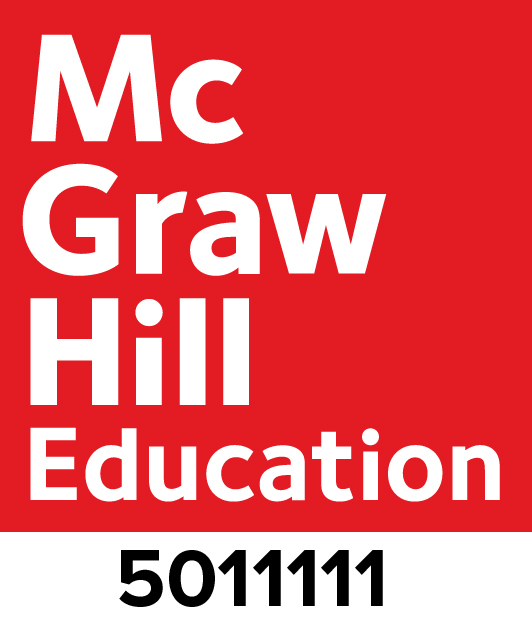
Page ix
A P ersonal W ord to S tudents
L ets be honest. Few of your college textbooks will change your life. But this one absolutely can.
This book will make you a better thinker. It will sharpen your mind, discipline your thinking, and help you make smarter decisions.
We will teach youstep by stephow to understand complex texts, analyze issues, think logically, and argue effectively. With effort on your part, this book will hone the thinking skills you need to succeed in college, in your career, and in life.
College is not ultimately about memorizing factsits about learning to think. And thats what this book is built to do. It will teach you the skills and attitudes you need to become a skilled thinker, an effective problem solver, and a sound decision-maker.
Together, the authors of this text have been teaching critical thinking for many decades. Teaching critical thinking is our passion. We have seen how it can change lives.
But college is like life: You get out of it what you put into it. Becoming a critical thinker is hard work. At times, this course will feel like boot camp. Theres a reason for that: No pain, no gain. Becoming a critical thinker means toning your mental muscles, breaking bad habits of flabby thinking, and developing powerful new habits of disciplined thinking and critical awareness. That requires effortand practice.
Thats why this text has so many exercises. There are tons of them, and all have been carefully selected and class-tested. You need to do the exercises, work through them, and then check the Answers to Selected Exercises at the back of the book. Practice. Make mistakes. Get feedback. And watch yourself become a better, more confident thinker.
Critical thinking is a challenge and an adventure. We hope you enjoy the book and the journey!
Page x
Page xi
Preface
Nothing is more powerful than reason.
Saint Augustine
T he first edition of Critical Thinking: A Students Introduction grew out of our conviction that a critical thinking text that worksthat produces real, measurable improvement in students critical reasoning skills, attitudes, and habitsmust have two essential features:
It must be a text that todays gadget-loving students actually read.
It must provide abundant, class-tested exercises that give students the practice they need to develop as maturing critical thinkers.
In revising Critical Thinking: A Students Introduction for this edition, weve tried to remain faithful to this original vision. Many passages have been rewritten to make the book clearer and (we hope) more engaging and accessible. In addition, several new readings have been added to keep the text timely and culturally relevant.
O verview of the T ext
Critical Thinking: A Students Introduction is designed to provide a versatile and comprehensive introduction to critical thinking. The book is roughly divided into seven major parts:
The Fundamentals: introduce students to the basics of critical thinking in clear, reader-friendly language.
Language: discusses the uses and pitfalls of language, emphasizing the ways in which language can be used to hinder clear, effective thinking.
Fallacies: teach students how to recognize and avoid twenty-two of the most common logical fallacies.
Page xii
Argument Analysis and Evaluation: offer a clear, step-by-step introduction to the complex but essential skills of argument analysis and evaluation.
Traditional Topics in Informal Logic: offer a clear, simplified introduction to three traditional topics in informal logic: categorical logic, propositional logic, and inductive reasoning.
Researching and Writing Argumentative Essays: provide students with specific, detailed guidance in producing well-researched, properly documented, and well-written argumentative essays.
Practical Applications: ).
The text can be taught in various ways. For instructors who stress argument analysis and evaluation, we suggest .
C ontinuing S trengths of the T ext
There are several features that set this book apart from other critical thinking texts:
A versatile, student-centered approach that covers all the basics of critical thinkingand morein reader-friendly language.
An abundance of interesting (and often humorous or thought-provoking) classroom-tested exercises.
An emphasis on active, collaborative learning.
A strong focus on writing, with complete chapters on using and evaluating sources ().
An emphasis on real-world applications of critical thinking, with many examples taken from popular culture, and complete chapters on the media and pseudoscientific thinking.
An extensive treatment of critical thinking standards and impediments.
A clear and detailed discussion of the distinction between deductive and inductive reasoning.
An abundance of thought-provoking marginal quotes, as well as Critical Thinking Lapsesoutrageous examples of poor critical reasoning.
Page xiii
This edition is available online with Connect, McGraw Hill Educations integrated assignment and assessment platform. Connect also offers SmartBook, which is the first adaptive reading experience proven to improve grades and help students study more effectively. All of the titles website and ancillary content is also available through Connect, including an extensive password-protected, user-friendly Instructors Manual, PowerPoint lecture notes, and a full Test Bank.
C hanging T imes , F resh M aterial
In preparing this edition, we have benefited greatly from feedback from students, instructors, and a host of anonymous pre-revision reviewers. Our grateful thanks to all! Major changes to this edition include:
Next page
